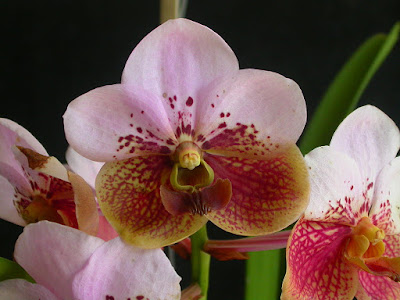Sanders Vanda is native to Philippines. Occurs endemically on the island of Mindanao, in the provinces of Davao, Cotabato and Zamboanga. They grow most often on tree trunks, and their habitats are low above sea level, usually below 500 m. This species has been over-collected and is considered rare in nature.
Vanda sanderiana orchid, also called as Sanders Vanda, Waling-Waling, Esmeralda sanderiana, Euanthe sanderiana, Euanthe sanderiana f. albata, Euanthe sanderiana f. immaculata, Vanda sanderiana var albata, Vanda sanderiana var froebelliana, Vanda sanderiana var. immaculata, Vanda sanderiana var labello-viridi, is a species of the genus Vanda. This species was described by Heinrich Gustav Reichenbach in 1882.
IDENTIFY VANDA SANDERIANA ORCHID
Sanders Vanda is native to Philippines. Occurs endemically on the island of Mindanao, in the provinces of Davao, Cotabato and Zamboanga. They grow most often on tree trunks, and their habitats are low above sea level, usually below 500 m. This species has been over-collected and is considered rare in nature.
Vanda sanderiana orchid is a large sized, monopodial, hot grower with an elongate stem, covered by imbricating sheathing bases carrying distichous, curved, coriaceous, ligulate, unequally bilobed or truncate apically leaves articulated to the persistent leaf sheaths below. The leaves are 30-40 cm long. The oldest leaves are deciduous after several years.
Waling-Waling blooms in the fall on 1 to 2, ascending, axillary, stout, to 12" (30 cm) long, 7 to 10 flowered raceme with long-lasting, fragrant flowers usually shorter than the leaves. Flower size is variable, but it is usually 9-11 cm wide. The wide, usually flat flakes of both whorls have rounded ends. The dorsal flower petal is slightly pink, tinted white. Slightly larger flakes are brownish-yellow with distinct brown-and-red veins forming a network pattern. The internal whorls are smaller, similar to the dorsolus, except for the brownish-yellow spots with red dots on the part adjacent to the outer petals. The relatively small, fleshy, concave lip is variable in color, but it is usually brown-yellow with red streaks on the inside. The dirty yellow shaft is very short. The alba variety has white flowers with green spots. As a plant, it resembles many other vandas, but when it blooms it is very easy to recognize.
GROW AND CARE VANDA SANDERIANA ORCHID
Cultural information should only be used as a guide, and should be to be adapted to suit you. Your physical location; where you grow your plants, how much time you have to devote to their care, and many other factors, will need to be taken into account. Only then can you decide on the cultural methods that best suit you and your plants.
Light:
Vanda sanderiana orchid needs a light level of 30000-40000 lux. The recommended photoperiod is 14 hours. Inadequate light causes the absence of blooms and very slow growth. Plants require a very clear position, but they should be protected from the direct sun. Strong air movement should be ensured all the time.
Temperature:
This species is a thermophilic plant. The average day temperature during the whole year is 29-31 ° C, night 21-22 ° C, which gives a daily amplitude of 8-10 ° C. Very small differences in average summer and winter temperatures at extreme temperatures differing little from medium temperatures indicate that plants can not tolerate major temperature changes.
In the period when night temperatures do not fall below 19 ° C, it is possible to place the Vanda sanderiana outdoors, remembering, however, that to grow and maintain the turgidity of the leaves will need 2 waterings a day.
Humidity:
This plant needs humidity of 80-85%, but can be adapted to slightly lower levels (65-70%) if temperatures do not exceed 27 ° C.
Substrate and growing media:
The ideal way to grow Vanda sanderiana orchid is a bare root, without sphagnum around the roots. This species produces very massive and expanded roots, which are covered by a thick layer of velamen, so they need air and are very sensitive to water stagnation. Considering these peculiarities, it can be said that the cultivation in pot is not suitable for this species. The maximum that could accept as a vase is a wide and shallow basket, made of wood, with large bark (5-8 cm) as a substrate.
Every few weeks, the substrate should be flushed to avoid the formation of mineral deposits, especially when using high doses of fertilizer or the water used is hard. Firstly, the plants should be watered normally to dissolve the accumulated salts. After about an hour, the substrate should be rinsed with water equal to twice the volume of the container. Flushing throughout the whole year is important especially where the water is highly mineralized.
Watering:
It gets water every day, preferably in the first part of the day. On hot days, two watering is necessary. The best way to water it is in the hot shower (water temperature 35-40 ° C), but it can only be used in areas with non-calcareous tap water. Otherwise we have to make some arrangements and imitate a hot rain, using the right water.
Fertilizer:
During the active growth of the plants should be fertilized every week 1/4-1/2 of the recommended dose of fertilizer for orchids. Before fertilizing the orchid it is important to water it to avoid the harmful contact of the manure with the dry roots.
You can use a fertilizer with low nitrogen content in the autumn and a high content of phosphorus. This contributes to better flowering in the next season and helps younger growth to reach maturity faster.
Rest period and repotting:
In winter, watering can be slightly reduced, especially if the plant is grown in such latitudes where there is less light and the days are shorter. However, these plants should never be dried. By limiting the watering during winter it is also necessary to reduce fertilization, returning to increased watering and fertilization in spring.















COMMENTS